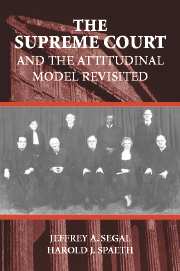Book contents
- Frontmatter
- Contents
- List of Illustrations
- List of Tables
- Preface
- 1 Introduction: Supreme Court Policy Making
- 2 Models of Decision Making: The Legal Model
- 3 Models of Decision Making: The Attitudinal and Rational Choice Models
- 4 A Political History of the Supreme Court
- 5 Staffing the Court
- 6 Getting into Court
- 7 The Decision on the Merits: The Legal Model
- 8 The Decision on the Merits: The Attitudinal and Rational Choice Models
- 9 Opinion Assignment and Opinion Coalitions
- 10 The Supreme Court and Constitutional Democracy
- 11 Conclusion
- Case Index
- General Index
4 - A Political History of the Supreme Court
Published online by Cambridge University Press: 05 June 2012
- Frontmatter
- Contents
- List of Illustrations
- List of Tables
- Preface
- 1 Introduction: Supreme Court Policy Making
- 2 Models of Decision Making: The Legal Model
- 3 Models of Decision Making: The Attitudinal and Rational Choice Models
- 4 A Political History of the Supreme Court
- 5 Staffing the Court
- 6 Getting into Court
- 7 The Decision on the Merits: The Legal Model
- 8 The Decision on the Merits: The Attitudinal and Rational Choice Models
- 9 Opinion Assignment and Opinion Coalitions
- 10 The Supreme Court and Constitutional Democracy
- 11 Conclusion
- Case Index
- General Index
Summary
This chapter presents an overview of the role the Court has played as an authoritative policy maker during the course of American history. The mythology described in Chapter 1 that surrounds the Court and its decisions has decreed that the only proper perspective from which to view the Court is a legalistic one, namely, the legal model that we critiqued in Chapter 2. To place the model that we employ – the attitudinal one – in a proper perspective, we present this historical summary.
THE FIRST SUPREME COURT
The eleven years before John Marshall became chief justice are typically viewed as the first Supreme Court. If we adhere to the modern practice of identifying Courts by their chief justice, two Courts preceded Marshall: the Jay Court from 1790 to 1795, and the Ellsworth Court from 1796 to 1800. Neither of them left a legacy akin to that of their successor Courts. By our count, these two Courts decided a grand total of only sixty-one cases, an average of less than six per year.
These Courts, however, did not want for eminent members. Jay himself was the third author of The Federalist Papers. Three of the five other original members served in the Constitutional Convention, as did Chief Justice Ellsworth and William Paterson, the author of the New Jersey Plan, whom Washington nominated in 1793. The others all supported ratification of the Constitution. Indeed, all of Washington's and Adams's nominees staunchly supported the Constitution and the federal government in its conflicts with the states.
- Type
- Chapter
- Information
- The Supreme Court and the Attitudinal Model Revisited , pp. 115 - 177Publisher: Cambridge University PressPrint publication year: 2002



